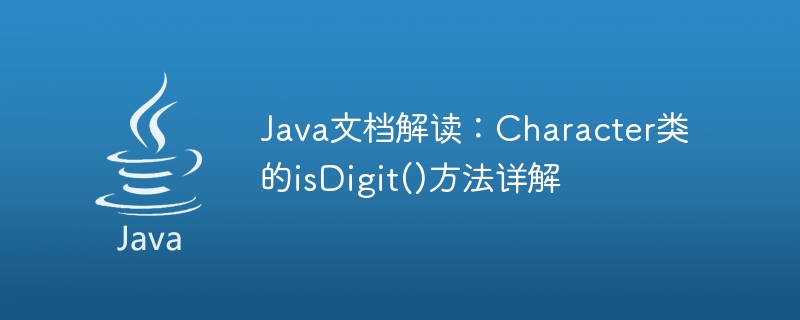

Interpretation of Java documentation: Detailed explanation of the isDigit() method of the Character class
In Java programming, the Character class is a wrapper class that represents Unicode characters. It provides many practical methods to manipulate characters, one of which is the isDigit() method. This article will analyze the usage and function of the isDigit() method in detail and provide specific code examples.
isDigit() method is used to detect whether the specified character is a number. It returns a boolean value that returns true if the specified character is a number; otherwise it returns false.
The following is the declaration of the isDigit() method:
public static boolean isDigit(char ch)
This method only accepts one parameter, which is the character to be detected. It can accept a parameter of type char, or an integer value representing a character. For example, the following example shows how to use the isDigit() method:
// Using characters as parameters
char ch1 = '9';
char ch2 = 'A';
System.out.println(Character.isDigit(ch1)); // Output: true
System.out.println(Character.isDigit(ch2)); // Output: false
// Use integers as parameters
int num1 = 7;
int num2 = 65;
System.out.println(Character.isDigit((char) num1)); // Output: true
System.out.println(Character.isDigit((char) num2)); // Output: false
In the code example, we first define two character variables ch1 and ch2, and assign the values to '9 respectively. ' and 'A'. Then, these two characters are detected through the Character.isDigit() method. In the first output statement, the result is true because '9' is a numeric character. In the second output statement, the result is false because 'A' is not a numeric character.
Next, we define two integer variables num1 and num2, assigned values 7 and 65 respectively. Convert the integer to a character through forced type conversion, and then detect the two characters through the isDigit() method. The output is the same as the previous example.
It should be noted that the isDigit() method can only detect whether a single character is a number, it cannot detect whether the entire string is a number. If you want to determine whether the entire string is a number, you can use other methods, such as regular expressions or Java's Number class.
In addition, the isDigit() method can only recognize numeric characters between 0-9 and cannot recognize numeric characters from other countries or regions. If you need to detect numeric characters in other character sets, you can use Unicode related methods.
To sum up, the isDigit() method is a very practical method for detecting whether the specified character is a number. It can help us make judgments and operations when processing characters. In daily programming, we can use the isDigit() method based on specific needs to improve the readability and maintainability of the code.
Code example:
public class DigitCheck {
public static void main(String[] args) {
char ch1 = '9';
char ch2 = 'A';
System.out.println(Character.isDigit(ch1)); // 输出:true
System.out.println(Character.isDigit(ch2)); // 输出:false
int num1 = 7;
int num2 = 65;
System.out.println(Character.isDigit((char) num1)); // 输出:true
System.out.println(Character.isDigit((char) num2)); // 输出:false
}
}The above code will output the following results when running:
true false true false
The above is the detailed content of Java documentation interpretation: Detailed explanation of the isDigit() method of the Character class. For more information, please follow other related articles on the PHP Chinese website!
